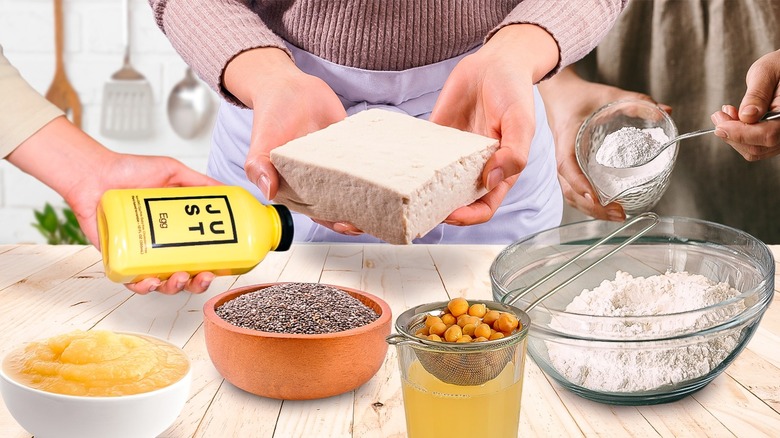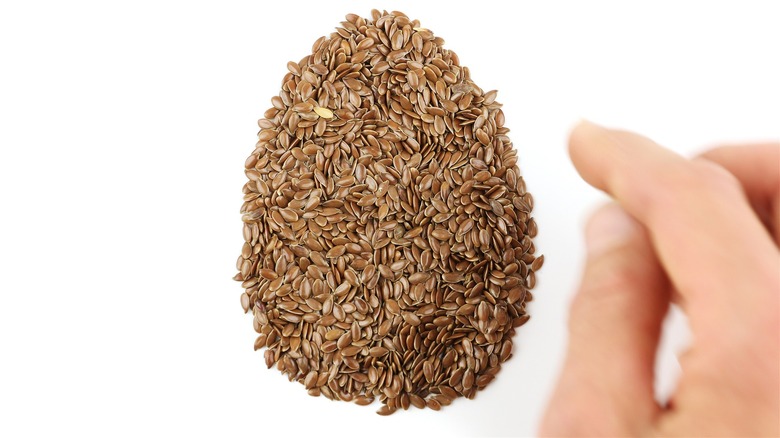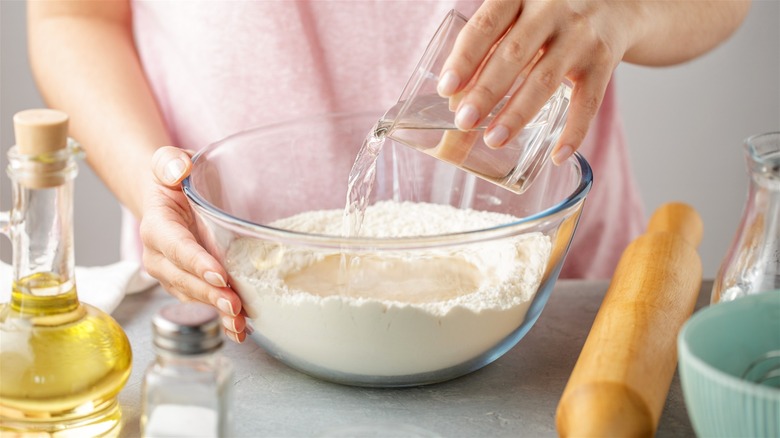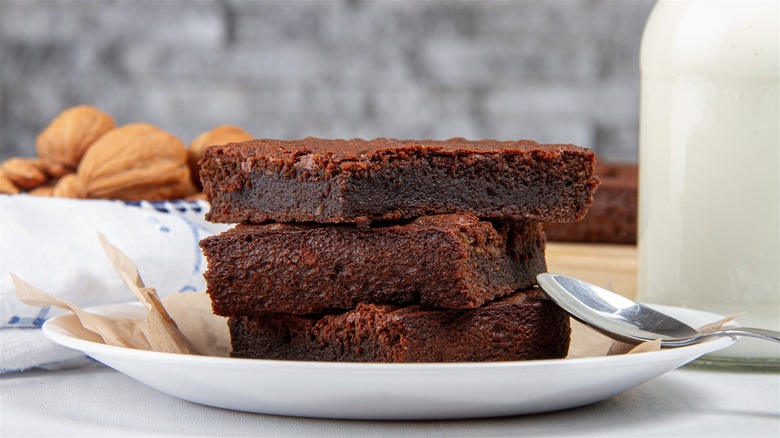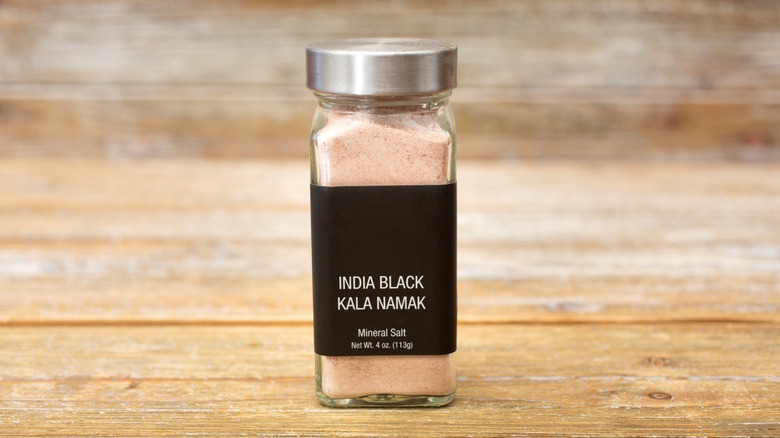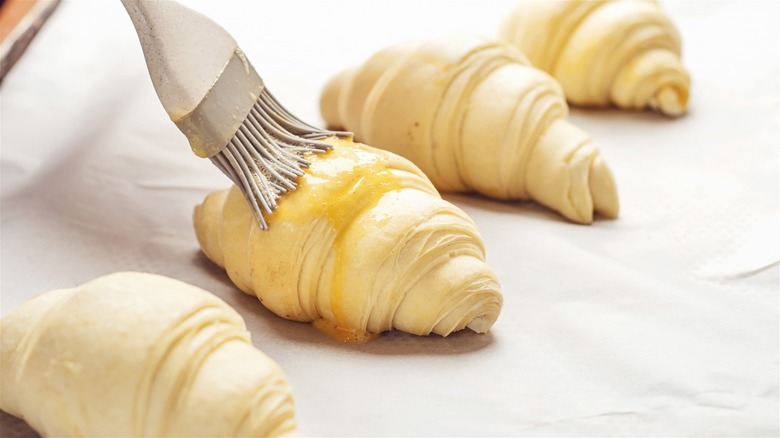15 Tips You Need When Cooking With Egg Substitutes
For the culinary adventurers among us, the plant-based path can sometimes resemble a thrilling quest for the Holy Grail, especially when it comes to cracking the code on egg substitutes. Whether it's due to personal preference, allergies, health considerations, or a vegan diet, more people are now embracing an egg-free lifestyle. And while it might be difficult to navigate at first, learning the art of egg-free cooking is a challenge worth undertaking.
Switching over to vegan egg alternatives has never been easier, either — there are at least half a dozen brands of easy-to-use, versatile liquid vegan eggs that are almost a perfect match to their animal counterpart. JUST Egg, for instance, made from mung beans and turmeric, boasts five grams of protein and is devoid of cholesterol, yet performs just like an egg — without the negative impact on your health or the planet.
But the journey doesn't end here. If you're in a location where such products are hard to come by, or if you're itching to master eggless baking, it's time to embrace the original egg substitutes, from various binders and leaveners to egg-like flavorings, healthy fat and protein-rich swaps, plant-based egg washes, and more.
Learn the role eggs play in a recipe
The key to successfully replacing eggs in a recipe lies in understanding what they are doing there in the first place. One of the jobs they perform is binding ingredients, which you'll see anywhere from meatballs to pasta bakes. Beating eggs (specifically, the protein-rich whites) turns them into a leavening agent by helping them form air pockets that lend volume and structure to baked goods and desserts. Eggs also create emulsions, allowing for the smooth incorporation of otherwise incompatible ingredients (as seen in any classic mayo recipe), thanks to the lecithin found in the fatty yolks. As the egg proteins coagulate when heated, they can thicken mixtures. And their high water content helps moisten batters. As a finishing touch, eggs can act as a culinary adhesive and add sheen to baked goods.
However, don't be fooled into thinking they're indispensable. Plant-based ingredients are fully capable of performing these roles. So, vegans, fear not. With a little understanding of how eggs function in recipes, you can successfully navigate the world of eggless cooking.
Pick the right substitute for the job
While there are many excellent egg substitutes, knowing which one will perform best in a particular recipe is just as important as understanding the role you're about to cast them in. Not all egg replacements are built equal; for instance, you wouldn't use a powdered egg replacer in an omelet or a flax egg in a custard.
In most batters, a mix of baking powder or baking soda with vinegar excels for leavening purposes. Soy lecithin is great for emulsion, while flax eggs work best for binding, particularly in dark-colored foods. Vegan yogurt or buttermilk can assist with dough rising, and starches are ideal for thickening custards, puddings, soups, and sauces. Plant milk or oil can enforce browning in baked goods. Aquafaba is a perfect stand-in for airy egg whites, and fruit purees bind and add moisture. Sparkling water works wonders for leavening crepes, cupcakes, and quick breads, while mashed bananas are excellent binders in dense, sweet baked goods. Lastly, for vegan scrambled eggs, omelets, and frittatas, you'll find capable substitutes in tofu, chickpeas, mung beans, and the flour of each.
Master the art of DIY egg replacers
Whether you purposefully choose the egg-free lifestyle or simply find yourself out of eggs when a late-night homemade brownie craving hits, you'll be happy to learn there's no need to give up on your dreams or take an extra trip to the store. Because you can, in fact, use pantry staples to replace eggs when baking!
A blend of 3 tablespoons of neutral-flavored oil and 1 tablespoon of water can mimic the fat and moisture of one egg. However, if you need to replace more, reduce the oil to 1 teaspoon, double the water, and add 2 teaspoons of baking powder to prevent a greasy outcome and achieve a good rise. This method works well in cookies, quick breads, and brownies. If you're an avid plant-based eater, your pantry could be more advanced, and you might have vegan staples like aquafaba and powdered egg replacer ready to go at all times. But you could also create your own egg replacer by mixing starches with baking soda and baking powder for an exciting food science experiment.
Watch the ratios
Cooking enthusiasts, new vegans, and plant-based recipe developers already know that when substituting eggs in a recipe, ratios are key. Commit them to memory, jot them down, or stick a handy printout on the fridge, but remember, in most cases, the overall weight of your egg substitute should match that of the eggs you're replacing, roughly 50 to 60 grams per egg.
The alchemy of 1 teaspoon of baking soda with 1 tablespoon of vinegar can work wonders in airy baked goods, while a tablespoon each of baking powder and vinegar can make your vegan pancakes puff up like a dream. For a denser switch, ¼ cup of fruit puree, vegan yogurt, or pureed silken tofu will do the trick. Or experiment with a mix of 1 tablespoon of flax or chia seeds with 3 tablespoons of water. Arrowroot starch requires a double portion for the same water content. In the game of egg part substitution, 1 tablespoon of soy lecithin can mimic each yolk, with 3 tablespoons of aquafaba impersonating an egg white. As for commercial egg replacers, just follow the script on the pack.
Don't push it
However healthy and versatile egg substitutes can be, they're not omnipotent. The harsh truth is that the more eggs there are in a recipe, the less likely a replacer is going to do a good job. It might be tempting to simply use whipped aquafaba to veganize an egg-heavy angel food cake recipe or go for a mix of starch and chemical leavening agents to create plant-based choux pastry, but unfortunately, it's far more complicated than that. That is to say, if you want to avoid kitchen disasters and food waste, focus on recipes with a smaller amount of eggs, especially if you're a novice to eggless cooking.
The good news is there are plenty of substitute-friendly dishes out there. You can make pecan pie muffins (as well as any other kind of muffins, cookies, and quick breads) with flax egg. You can make zucchini brownies and other dense baked goods like banana bread with avocado, banana, or applesauce. And, in a feat of miraculous plant-based mirroring, you can make an egg-free meringue entirely from aquafaba, the liquid from canned chickpeas.
Mind the color and flavor
Aesthetics are another thing to pay attention to when trying to recreate familiar dishes the eggless way. Because as much as food science and ratio precision matter, so does the presentation. Remember that most egg substitutes will affect the flavor of the end product, which, when used wisely, can be turned into an advantage.
The go-to whole-food egg substitute for baking, ground flax seeds, is known to lend a mild nutty flavor, as well as a speckle of brown to batters, so if you want pristine vegan vanilla cupcakes, go with a mix of applesauce and powdered leaveners instead, and reserve the flax eggs for brownies, chocolate cookies, and bran muffins. Mashed bananas will also enhance browning but add a prominent flavor, which isn't always welcome. A mix of baking soda and vinegar should be reserved for substituting recipes with a limited amount of eggs, or the vinegar flavor will outshine the rest. Finally, a powdered egg replacer is really useful when trying to substitute with minimal changes to the looks and flavors of baked goods.
Learn how to stabilize aquafaba
The starchy liquid from canned beans, dubbed aquafaba, might be the closest vegans will ever get to egg whites. You can use it on its own, unwhipped, as a binder, thickener, and emulsifier in batters, soups, and vegan mayo, but its miraculous nature truly shines in vegan meringue. When it comes to this dessert, aquafaba is a perfect substitute in every way — meaning it also needs proper handling to work its magic.
Much like egg whites, whipping aquafaba into stiff peaks can be a challenge. The secret? Spotless utensils, as any fat residue can ruin the foaming process. Stuck with a stubbornly oily bowl? Distilled white vinegar spread in a couple of tablespoons on a paper towel can save the day. But there's also another secret to a stable aquafaba meringue, and that's cream of tartar. Not only does it ensure the air and water hold on to each other in the foam, but it also prevents premature browning during baking. Use ⅛ teaspoon of the powder per 2 tablespoons of aquafaba for best results.
Combine multiple egg replacers
Who said you can't put all your egg replacers in one basket? As you learn more about the multifaceted culinary nature of eggs and their many plant-based substitutes, you'll notice that hardly any of them can simultaneously perform multiple roles as eggs do. In baking, eggs often wear all of their hats, providing structure, volume, and flavor, binding and leavening at the same time. So, naturally, you want to experiment with combining several different egg substitutes to achieve similar results.
For instance, fruit purees that add moisture to the batter are incapable of leavening it, so they'll need a leg up from baking powder. Thus, for every ¼ cup of applesauce, sprinkle in ½ teaspoon of baking powder, or you risk the finished product turning out too dense. Similarly, buttermilk should only be used in the presence of another leavening agent, such as ¼ teaspoon baking soda for every egg you're replacing with it, or you won't get a proper rise. Finally, yogurt can work as a leavening agent, so it can support flax and chia eggsthat might otherwise act as binders.
Use fatty ingredients to imitate yolk's mouthfeel
The egg yolk, a splendid globule of fat and lecithin, plays the noble part of binder and emulsifier in the culinary world, trapping moisture and lending a velvety richness to any concoction it's a part of. Yet, for the vegan gourmand, there are plenty of ways to mimic this golden blob of cholesterol using plant-based ingredients. The secret? Embrace the fat.
Coconut milk, avocados, cashews, oils, and even vegan mayo can stand in for yolks, infusing your dishes with the depth and sumptuousness we often associate with egg yolk. Just remember to keep the wet and dry ingredient ratio balanced. Pureed silken tofu holds great textural potential, ideal for both sweet and savory applications, while nutritional yeast can up the umami. Vegan mayo and soy lecithin serve as great emulsifiers, while flax seeds, with their fatty acid richness, can lend a helping hand in binding. For a taste of creamy decadence, use blended cashews in custard, and keep in mind that full-fat coconut milk can be a great way to avoid adding egg yolks to homemade ice cream.
Sometimes, water is enough
Leavening is one of the key jobs eggs perform in baking. This process is crucial since it helps food expand due to air entrapment or releasing gas when exposed to heat or acid. But it can't happen without a leavening agent. It's what helps your cakes and muffins rise and have a light, airy texture. Egg whites are the usual suspect, as are bicarbonate of soda, baking powder, and yeast. Yet, there's an unexpected bubbly ingredient in this egg replacer lineup: sparkling water.
In terms of ratios, ¼ cup of carbonated water is deemed equal to one egg. While it may seem counterproductive to introduce this much moisture, it turns out to be a surprisingly effective substitute. For one, it brings the much-needed gas and air into the mix, enabling your dough to rise gracefully without imparting any strong substitute flavor or unwanted browning, which sometimes happens with chemical leaveners. While it works wonders in crepes, it's not a one-size-fits-all solution. However, paired with the binding prowess of a chia egg, it works wonders in recipes like pancakes and muffins.
Starches are your friends
If you've ever looked at the ingredient list of a commercial egg replacer, you've noticed that it usually has one (or three) different types of starch. Starches, you see, are the shelf-stable understudies to eggs, adeptly mimicking the thick, jelly-like consistency eggs provide in custards and sauces or the light and airy texture in baked goods. Arrowroot powder is a favored choice, offering an egg substitute par excellence when combined with water. It also double-books as a binder, particularly in gluten-free recipes, and its resilience under acidic conditions makes it a hero in fruit pie recipes.
But though arrowroot gets most of the spotlight, there are plenty more starch types to choose from. Corn, potato, and tapioca starches, when mixed with water in 2:3 proportion, offer capable stand-ins for eggs in various dishes. Still, you need to be aware of different gelatinization temperatures. For instance, cornstarch has one of the highest, meaning it works best in baking, thickening within the range of 144 to 203 degrees Fahrenheit. Yet it also holds up to freezing relatively well, making it a welcome ingredient in an eggless gelato.
Don't forget about the protein-rich subs
Baking takes prowess and an understanding of food science. However, replacing eggs in a dish that traditionally highlights them as a standalone component can be more amusement than a chore. It's in this realm where the shackles of ratios and chemical reactions loosen, freeing you to immerse in the pursuit of flavor and texture.
Tofu, chickpeas, mung beans, and chickpea flour make the best alternatives to eggs for a protein-rich breakfast. Plus, they have no cholesterol! And while a tofu scramble or a mung bean omelet can be a tad more work than just cracking an egg into a pan, it's worth it in terms of health — both yours and the planet. But the best news, of course, is that the growing demand for plant-based alternatives caused by climate anxiety and global health concerns has been met with plenty of commercial liquid vegan eggs. Simply look at JUST Egg, Simpy Eggless, and the like, which actually take less work to prepare than conventional eggs — you just have to crack open a bottle instead of a shell, and you're good to go.
Use black salt to increase egginess
It certainly pays to know how to replicate eggs' functions, but what about their flavor? If the original dish places them front and center, using an egg substitute like tofu or chickpea flour won't cut it — increasing the eggy flavor should be your goal as well. Enter kala namak or the ingredient that will change your vegan recipes forever. It's not an egg substitute per se, as it doesn't replace the functionality of eggs, but it compensates with its uncanny ability to replicate their characteristic flavor.
Hailing from India, kala namak is a type of salt known for its unique sulfurous aroma that's eerily reminiscent of eggs, breathing life into dishes that usually miss that eggy touch. Whether it's a tofu scramble, a chickpea omelet, or an eggless French toast, a pinch of black salt can transform it into a convincing egg-based dish. But remember, timing and quantity are key. Adding black salt during cooking can cause its flavor to evaporate, so it's best added at the end. And tread lightly, for in the realm of black salt, less is often more.
Make your egg wash plant-based with pantry staples
Have you ever wondered what's behind that appetizing glimmer, seductive golden color, and delectable crispy crust of a freshly baked croissant? Or how that pearl sugar stays on top of Swedish cinnamon buns? Or how the edges of hand pies manage to stay together? The answer is egg wash — a mixture of eggs beaten with a liquid such as water or milk. Sadly, it's also what makes a lot of accidentally vegan products not suitable for those on a strictly plant-based diet. But don't fret: at least with your homemade baked goods, you control the narrative.
One creamy egg wash substitute you probably already have in your fridge is mayonnaise. And while regular egg-based mayo is a no-go for vegans, plant-based mayo does the trick just as well, thanks to its oil content. And there are plenty more options to experiment with: simply brushing some melted coconut oil, fruit preserves, or a mix of plant milk and maple syrup on top of your pastries can help with browning, while combining JUST egg with plant milk creates a universal egg wash substitute.
Don't use egg replacer where it's not necessary
Our final word of advice on working with egg substitutes: Don't overthink it. It's a simple truth that some recipes, contrary to popular belief, can perfectly do without eggs. So why add another ingredient if it's not playing a functional role in the product? Instead, work from the ingredients already present in a recipe.
For instance, if you've been asking yourself what should you use in place of eggs for vegan stuffing, the answer is that you don't have to replace them at all. Sure, eggs add a binding touch, but omitting them doesn't cause a culinary catastrophe. Instead, a little extra vegetable stock, and a splash of white wine, and you're in business. Eggs do add a certain smoothness, but a dash of oil, a pat of vegan butter, or a spoonful of egg-free mayonnaise can mimic this marvelously. And for those yet to dabble in veganism, fret not over your meatloaf or meatballs. Meat proteins are quite capable of playing the role of the binder. So, fear not the eggless endeavor and embrace the art of simplicity.
